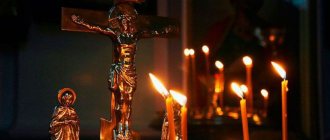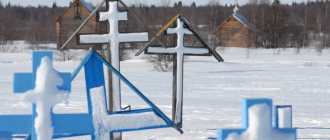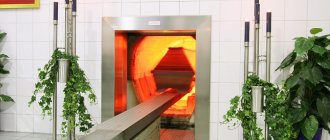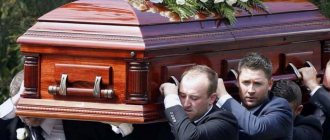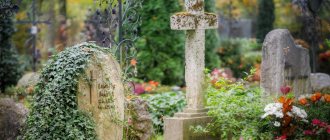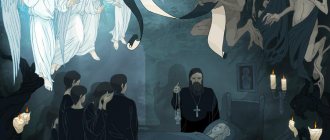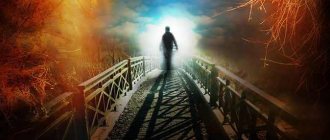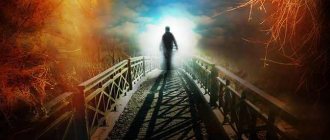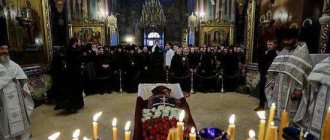| Kiev-Pechersk Lavra |
Kiev-Pechersk Lavra in honor of the Dormition of the Blessed Virgin Mary
, stauropegial monastery of the Ukrainian Orthodox Church within the Kiev diocese, one of the most important, oldest, largest, and most famous monasteries in Russia
- Address: Ukraine, 01015, Kiev, st. Lavrskaya, 15, bldg. No. 42
- Tel.: 255-11-05 (office [1])
- Official site:
- Directions: from the station. m. "Arsenalnaya" - bus. 24 to the stop. "Museum of the Great Patriotic War", "Kievo-Pechersk Reserve"
- On the map: Yandex.Map, Google map
For centuries, the main attraction of the Kiev Pechersk Lavra has been the caves in which the holy founders of Russian monasticism labored.
The Lavra caves were first mentioned in the “Tale of Bygone Years” by St. Nestor the Chronicler (beginning of the 12th century).
The chronicler names the founder of the cave retreat on the site of the future monastery as priest Hilarion, an outstanding ascetic and theologian who served in the Church of the Twelve Apostles in the Kiev suburb of Berestovo. Hilarion chose a picturesque hill not far from Berestov for prayerful solitude and, like the first Christian ascetics, having dug a two-foot cave in it, he secluded himself in it for prayer. An outstanding church and statesman, confessor of Yaroslav the Wise, Hilarion in 1051 became the first metropolitan of Russian origin. Upon his election to the Kyiv See, the cave in Berestov was empty. In the same year, the Monk Anthony of Pechersk, who returned from Mount Athos, settled there and laid the foundation for monastic work here. It is this date, 1051, that Nestor the Chronicler indicates as the year the cave monastery was founded.
| Kiev-Pechersk Lavra |
The piety of Saint Anthony attracted followers to his cave, among whom was the Monk Theodosius, who later became the abbot of the monastery and the pioneer of cenobitic monasticism in Rus'.
Anthony's disciples, having settled near him in a cave, dug out new cells for themselves, connecting them with corridors. The first temples were also built in caves. Ten years later, when the number of the brethren reached twelve people, the Monk Anthony, who always strived for solitude, retired to another hill, where he dug a new cave for himself, thus laying the foundation for a complex of caves, later called Near (or Antoniev). The original caves were called Dalniye (or Feodosiev). With the increase in the number of monks, the caves became too small for the brethren, and they built the above-ground Church of the Assumption of the Blessed Virgin Mary and cells. The number of people coming to the monastery kept increasing, so Anthony asked Grand Duke Izyaslav Yaroslavich for the entire mountain above the cave. The resulting monastery was named Pechersky.
After the burial of St. Anthony in the caves (+ 1073), the brethren began to be buried here. To do this, niches were dug in the walls of the caves up to two meters deep, up to half a meter high and wide. The body of the deceased was placed on a board and pushed into a narrow niche, which was covered with a wooden shield, and later walled up. According to the custom established in the Pechersk monastery, after two years the burials were opened and the bone remains were transferred to the crypts - ossuaries. If it turned out that the remains of the ascetics were preserved incorrupt, they were left in the same place. The relics of St. Theodosius in 1091 were solemnly transferred to the Great Assumption Church, built in 1089, and the relics of other ascetics until the 17th century. remained in cave crypts. The relics of St. Theodosius were in the Assumption Cathedral until 1240. During the invasion of Batu's hordes, due to the danger of desecration, they were hidden, and the place of their burial is unknown. The names and spiritual deeds of the Pechersk monks, whose imperishable relics rested in the caves, were still in the memory of the brethren at the time of their discovery and were briefly written down on the boards covering the burials. From these boards, information about the saints was subsequently copied and preserved in the Pechersk Patericon. The faces of saints were written on the same boards, many of whom, already in the first decades of the existence of the Pechersk monastery, were revered as locally revered saints.
In 1108, St. Theodosius of Pechersk was canonized, and in 1133, St. Anthony. In 1643, Saint Peter (Mogila), Metropolitan of Kiev, canonized 69 Pechersk ascetics. Since that time, the Kiev-Pechersk Lavra has become the main Russian shrine - the Russian Jerusalem, a center of pilgrimage for believers. At the same time, for the greater convenience of pilgrims, the dilapidated caves were landscaped. Narrow and collapsed corridors were strengthened and expanded in such a way that two people could easily pass each other in them. Ancient cave churches were reconstructed: in the Near caves - the church in the name of St. Anthony of Pechersk and the Entry of the Blessed Virgin Mary into the temple, in the Far caves - the Annunciation and the Nativity of Christ, and new churches were built: in the Near caves - in the name of St. Varlaam (1691), and in the Far East - St. Theodosius of Pechersk (beginning of the 18th century).
For centuries, the caves served as a place of prayer and ascetic deeds of monks, a repository of shrines and a refuge for the inhabitants of Kyiv during the years of hard times and foreign invasion. Not only in ancient times, but also in times closer to us, when Kyiv was threatened by enemy raids, Orthodox shrines were hidden in the caves of the Lavra. Thus, in 1978, in one of the crypts of the Near Caves, archaeologists discovered a walled-up bottle with a letter signed by Archimandrite Valery (Ustimenko), who had been the rector since January 1942, and since 1944 the governor of the Kiev Pechersk Lavra (+ 1950). ). In a letter dated July 1942, it was reported that upon returning to the monastery, the brethren found in the sacristy of the Far Caves the holy relics of the Great Martyr Barbara, the Holy Martyr Macarius, and Metropolitan Raphael (Zaborovsky), which were previously in St. Sophia of Kyiv and the Vladimir Cathedral. The Kiev Pechersk Lavra was closed by the atheistic authorities in 1930 and resumed its activities in 1941, after the German occupation of Kyiv. It was closed for the second time in 1961, during the period of the so-called Khrushchev persecutions. Since 1988, after decades of atheistic persecution, the Kiev-Pechersk Lavra was again open to believers as a functioning monastery, and worship and prayer resumed in the caves. The first Divine Liturgy after a long break was celebrated on June 25, 1988 [2].
Statistics
- XVII century - up to seven thousand monks [3]
- 2009 - approx. 100 monks, approx. 50 novices [3]
- 2013 - 180 monks and novices [4]
- 2018 - 220 monks [5]
| Great Church of the Kiev Pechersk Lavra. Painting, V. P. Vereshchagin, 1905 State. Vladimir-Suzdal Historical, Architectural and Art Museum-Reserve |
Temples of the Kiev Pechersk Lavra
The original layout of the Lavra building has been preserved to this day, in perfect harmony with the relief landscape of the right bank of the Dnieper. The monastery is located on high hills, between which there is a deep ravine, dividing it into the so-called Upper Lavra, where else in the century. The main part of the brethren moved, and the Lower Caves, where the Near and Far Caves and the hospitable courtyard are located. Each of the complexes of the ancient monastery consists of several temples, administrative, residential and utility buildings.
On the upper territory around the Assumption Cathedral (the main temple of the Lavra) there are cells of the monastery's hierarchy and brethren, economy buildings, a printing house, a hospital monastery and workshops. The Great Lavra Bell Tower and the fraternal refectory with the church are also located here. To the south, on the hillside, there is an entrance to the Near Caves, and on the southernmost elevation - to the Far Caves. All parts that make up the Lavra are separated by high stone walls and connected by gates and galleries; they complement each other and generally represent a cross-architectural ensemble.
The State Historical and Cultural Reserve has been located on the territory of the Upper Monastery since the 1920s, since the establishment of the atheistic government, to this day. There are four gates leading to this part of the Lavra: Western (Holy Gates with the Trinity Gate Church); Northern (Economic Gate with the Church of All Saints); Eastern and Southern (or Cave). The main entrance to the Lavra is the Holy Gate. Above the Holy Gates of the Lavra there is a church in the name of the Holy Life-Giving Trinity, the oldest surviving one. It was built in the 12th century. Rev. Nikola Svyatosha, great-grandson of Yaroslav the Wise.
| Great Pechersk Church (Assumption Cathedral) |
The main temple of the Kiev Pechersk Lavra - the Great Pechersk Church (Assumption Cathedral) is located opposite the Holy Gates, in the middle of the central square of the Upper Lavra.
According to the testimony of the Venerable Nestor the Chronicler, the stone Church of the Assumption in the Pechersk Monastery was founded with the blessing of the Venerable Anthony by the holy abbot Theodosius and Bishop Michael in 1072. Time destroyed this temple, transformed it and recreated it again as an unshakable shrine of Orthodoxy. All the main shrines of the Lavra were always kept in the Great Church. To the northwest of the Assumption Cathedral, next to the Trinity Church, there is the entrance to the former Nikolsky hospital monastery with a church in the name of St. Nicholas, founded by the Monk Nikola Svyatosha in the 12th century. Here he spent the rest of his days, caring for the elderly and sick monks.
The one-story buildings on both sides of the dark granite path, laid from the Holy Gates to the Assumption Cathedral, are the former cells of the cathedral elders. These cells were erected at the beginning of the 18th century. on the site of the previous wooden ones, which burned down during the fire of 1718. In the cells of the cathedral elders of the Lavra, today there are shops and exhibition halls of the reserve.
The northern gate (Economic) is crowned by the gate church of All Saints, built in 1696-1698. dependent on Ivan Mazepa.
Leaving the Lavra through the Economic Gate and moving a little to the north, you can see the Church of the Transfiguration of the Lord, more often called the Savior on Berestov, - a most valuable architectural and historical monument, included, like the entire architectural complex of the Kiev-Pechersk Lavra, in the list of world cultural monuments, under the protection of UNESCO.
| Refectory Church in the name of Saints Anthony and Theodosius of Pechersk |
Next to the Great Lavra Church there is a wide-domed “neo-Byzantine” style temple in honor of St. Anthony and Theodosius of the Pechersk with a refectory chamber (Refectory Church). The Church of St. Anthony and Theodosius, which has survived to this day, connected to a two-story fraternal refectory, was built in 1893-1895.
| Iconostasis of the Refectory Church in the name of Saints Anthony and Theodosius of Pechersk |
The Church of the Annunciation of the Blessed Virgin Mary is adjacent to the Refectory Chamber on the eastern side, and on the western side to the house of the Lavra’s abbots - the Kyiv Metropolitans.
Currently, the Museum of Ukrainian Decorative Arts is located in the metropolitan chambers and the Church of the Annunciation. To the west of the Metropolitan's chambers is the former house of the Lavra's governor, next to which stands the Lavra's tallest and most majestic building - the Great Lavra Bell Tower, built in 1731-1745.
On the eastern side of the Great Church there is a printing house of the Kiev-Pechersk Lavra established by Archimandrite Elisha (Pletenetsky) (1596-1624).
From the main Lavra courtyard between the buildings of the former printing house and the icon painting school, there is a descent leading to the caves, ending with the so-called Cave Gate.
The modern monastery of the Kiev-Pechersk Lavra occupies the territory of the Near and Far caves and several buildings of the former Lavra hostel. Directly opposite the Cave Gate there is a former bookstore adjacent to the monastery garden, in the building of which the Pilgrimage Department of the Lavra is currently located.
The bell tower at the Near Caves was built in 1759 – 1763. Stepan Kovnir. The two-tier bell tower is 27 meters high. In its architecture, it resembles a gateway, since a hundred-meter-long covered gallery passes through its first tier, connecting the Upper Lavra with the territory of the Near Caves. In the lower part, the gallery passes through the vestibule of the church in the name of All Saints of the Pechersk. Almost at the foot of the mountain there is an area surrounded by the buildings of the Near Caves. On the side of the hill, under one roof, adjacent to each other, stand the Church of the Exaltation of the Cross and the Church of All Saints of the Pechersk (Warm Temple).
| Church of the Exaltation of the Cross of the Kiev Pechersk Lavra from the southeast. Photo 2009 |
The Church of the Exaltation of the Cross has not been rebuilt and has remained in its original form to this day.
On its northern side it is adjacent to a hill in which caves have been dug. Three entrances to the Near Caves were cut from the temple: from the vestibule, refectory and sacristy. In 1749, presumably according to the design of the architect Johann Schedel, on the eastern side, near the altar asp, a gallery was added to the temple, from which another entrance to the caves was made. The northern wall of the gallery serves as a retaining wall for the cave temple, and the southern wall, which was an open arcade, was converted into windows in the 1880s. From the beginning of its foundation, the Church of the Exaltation of the Cross served as a burial place for clergy. The Church of All Saints of the Pechersk is the second above-ground temple on the territory of the Near Caves. The building was built in 1839 as fraternal cells. In 1872, on the second floor a church was built and consecrated to all the Reverend Fathers of the Kiev-Pechersk. The consecration of the church on the second Sunday of Great Lent of that year is also associated with the establishment of the celebration of the Council of all Kiev-Pechersk Saints on this very day [6]. The courtyard of the Near Caves is supported by a supporting wall, from which a staircase descends, then a paved path leads to the wells of St. Anthony and Theodosius. In 2002, chapels were erected over the wells.
At the exit from the Lavra to the Dnieper there is a temple in the name of the icon of the Mother of God “Life-Giving Spring”, surrounded on all sides by a fortress wall. In 1914 - 1915 on this site a chapel was built over an artesian well, the construction of which was supposed to improve the drainage of the cave hills.
Coming out of the gallery onto the square near the Far Caves, we will see a majestic temple in the Ukrainian Baroque style rising on a hill - the Church of the Nativity of the Blessed Virgin Mary. Around 1062, the first above-ground church of the Dormition of the Mother of God was built on this site in the “Old” monastery. After the consecration of the Great Assumption Church, the temple above the Far Caves became a cemetery. The ancient necropolis of the monastery was formed around it. No information has been preserved about further reconstructions of the temple, but in the first half of the 17th century. it was already named in honor of the Nativity of the Blessed Virgin Mary. The stone Church of the Nativity of the Blessed Virgin Mary, built in 1696 at the expense of a relative of Hetman Mazepa, Bila Tserkva Colonel Konstantin Mokievsky, under Archimandrite Meletius (Vuyakhevich), is a masterpiece of Ukrainian architecture of the 17th century. Upon the return of the lower territory of the Lavra to the Church, the Church of the Nativity of the Virgin Mary was repaired and re-painted. Currently, it is an academic church where students of the Kyiv Theological Academy and Seminary gain experience in worship. Clergy and secular persons who had significant services to the Church and the state are buried at the Rozhdestvenskoe cemetery.
To the west of the church stands the beautiful and slender bell tower of the Far Caves, built in 1754 - 1761. according to the type of gates by Stepan Kovnir. The height of the bell tower is 41 m.
| Annozachatievskaya Church of the Kiev Pechersk Lavra. Photo 2013 |
The Church of the Conception of Righteous Anna (Annozachatyevskaya) is located northeast of the Nativity - Church of the Mother of God.
This stone temple was built in 1679 with donations from a resident of the Pechersk town, Alexander Novitsky. The church acquired its modern appearance in 1809, after reconstruction according to the design of military engineer architect Alexander Yakushkin. He is also the author of the wooden gallery with a stone tower at the entrance to the caves. In 1811, the architect Yakushin took monastic vows at the Lavra with the name Arseny, was a cathedral elder and guardian of the Far Caves, and at the end of his earthly journey he was buried in the crypt of the Annozachatyevsky Church, built by him during construction. A narrow and steep staircase leads from the vestibule of the Annozachatyevskaya Church to the caves. The exit from the caves is via a flatter staircase in the former funeral room, where one of the church shops is currently located. Above the entrance to the Far Caves, a structure dating from the 18th century has been preserved to this day. used as a sacristy. On the plan of the caves given in the Kiev-Pechersk Patericon of 1661, it is indicated as a temple in honor of St. Apostle Andrew the First-Called.
Next to the bell tower, in the building formerly occupied by the guardian of the Far Caves, there is the office of the Metropolitan of Kyiv and All Ukraine.
Since the 17th century, where the Monk Theodosius set up an almshouse in 1056, the construction of a hospitable courtyard began - a whole complex of hotels for pilgrims. The hospice house, located on a hill above the Near and Far caves, occupies a quarter of the monastery’s territory.
See also Near Caves, Far Caves.
| Scheme map of the Kiev Pechersk Lavra |
“For a believer, the main law is Christ”
Bishop Pavel (Lebed), Metropolitan of Vyshgorod and Chernobyl, is a staunch defender of the Kiev Pechersk Lavra in modern history. For 25 years he has been obedient to her governor. Through the labors and wisdom of the ruler, not only the buildings of the Lavra rose in their beauty from the ruins, but spiritual life was revived. The Lavra brethren constantly pray for the whole world: as soon as a service ends in one of the Lavra churches, the next one begins in another. Thousands of pilgrims, tourists and people who just happened to come here out of curiosity experience another dimension of life: “My kingdom is not of this world: even if it were of this world... My servants would fight, lest he be delivered over to Judea” (John 18) : 36).
Metropolitan Paul says: “If we walk in Christ’s truth, we draw closer to holiness.” The Bishop shares with readers of the Pravoslavie.Ru portal about the holiness that was, is and will be in the Church, about his experience of meeting saints and ascetics in Russia and Ukraine.
Metropolitan of Vyshgorod and Chernobyl Pavel (Swan)
– Vladyka, please tell us about those ascetics whom the Lord sent to you on your life’s path.
– The Lord gives holiness of life for our admonition.
I can talk for a very long time, because I am a sinful monk, but I have seen holy people and lived with holy monks.
Bishop Damian (Marchuk)
– The first to meet on the path of my salvation was the late Bishop Damian (Marchuk). A meek, humble, wise man. He determined my fate by giving me a recommendation to enter the Moscow Theological Seminary in 1984. Then many students wrote in their recommendations: he reads, and sings, and “walks on the waters,” and “gathers stars from the sky,” but I only had two words: “I recommend enrolling.” And when I saw on the table of the late Bishop-Rector Alexander (Timofeev) what was written in my recommendation, then, of course, fear attacked me, a cold ran through my body, I thought: “My God, 800 people are admitted, 100 are accepted, and such a recommendation..."
Vladyka Alexander asked me if I knew Vladyka Damian. I said I know. I inquired about his state of health, we talked a little, and I was accepted. From that moment my spiritual life began.
Archbishop Damian (Marchuk)
Bishop Damian predicted the day of his death. He asked Father George (who is now serving in Germany): “Prepare a place, we will have a deceased person on Thursday.” - "Who?" - "I will die". And indeed, on the Thursday before Trinity, he died, and on Trinity Saturday we buried him. Thousands and thousands of people came. He was a man of deep faith, who endured everything on his life’s path.
In the Trinity-Sergius Lavra
– I will forever remember my studies at the Trinity-Sergius Lavra, where I learned the first basics of faith. And to this day I remain a deeply religious person and devoted to the Russian Holy Church. What did we know when we came to the theological school from the village? We knew that there is a Life-Giving Trinity, we knew the holidays, we knew the fasts, we kept the commandments, we read the Gospel. And I think that for Christian life in Soviet times, when the Church was persecuted, this was enough.
Trinity-Sergius Lavra
When I brought the documents, Vice-Rector Mikhail Stepanovich Ivanov asked me why I came, because neither recognition nor salary awaits me here. I rebelled in my heart and asked him, “Why are you talking to me like this?” And he answered: “Peter, those who are not firm in the faith will fall away, but true Christians will remain. The Church does not need mercenaries, but shepherds.”
Archbishop Alexander (Timofeev)
I have developed a very good relationship with Bishop-Rector Alexander. After I survived the fire and five people from my room burned to death, he treated me like a father. And I always pray for him. His death was blissful - on Christmas itself. He said goodbye to everyone, served the Liturgy and left. So the Lord showed us the righteous: “honorable before the Lord is the death of His saints.”
During my studies, the ideals of life for me were Archimandrites Benedict, Plato, Cyril, Naum, Athanasius, the late Anastasius, Matthew, and the brethren of the Trinity-Sergius Lavra. I looked at them and, like a sponge, absorbed their words.
Archimandrite Kirill (Pavlov)
It was touching: after the reading, Father Kirill gave us students a piece of bread or two “Bear-Toed Bear” candies.
I really loved Archimandrite Kirill (Pavlov). We gathered in his cell in the evenings, and Father Kirill always read the Holy Scriptures of the New Testament himself, and allowed me to read the Philokalia and the Old Testament. Not every day, but sometimes. And it was very touching: after this reading, he gave us students a piece of white bread and two pieces of fish or two “Bear-toed Bear” candies. Hieroschemamonk Moses, a scientist, mathematician, and author of textbooks for high school, also attended the readings. When he fell asleep while reading, and Father Afanasy poked him in the ribs, Father Kirill said: “Don’t touch him, he’s talking with angels.” This was the kind of love Father had! This love touched our hearts. The Church in due time will speak about the feat of the holy life of Father Kirill.
And you know what amazed me? When I served with him on Easter, he threw Easter eggs - there were simple ones, painted ones, and stone ones - about 300 or more. Father tried to ensure that everyone received a blessing from him. This sunk into my soul so much that when I served in the parish, I did the same.
Archimandrite Matthew (Mormyl)
I come to the rehearsal with a book, and Father Matthew: “And I found it, and I found it,” and smiles
Father Matthew (Mormyl) somehow lost a book, and he told me: “That’s it, you won’t live if you don’t find it!” And I was a charterer. What to do? I came to Father Onuphry - then the dean of the Trinity-Sergius Lavra, and now he is our dear primate of the Ukrainian Orthodox Church - and I said: “Father Matthew said: there will be no life for me.” (He was kind, but very strict!) - “As he said, so it will be! Go to Anastasius." I'm coming. Anastasius says: “My prayer does not rise higher than the Lavra bell tower, so go back to Onuphry, he has such a book, he will give it to you.” I come to the rehearsal with a book, and Father Matthew sits: “And I found it, and I found it.” Of course, anger began to boil in my soul: “What should I do with this?” - “I have it, you have it too.” And smiles.
All these wonderful elders will forever remain great teachers for me, and the Trinity-Sergius Lavra will remain a school of piety.
On arrival
– After graduating from the seminary in 1988, I was sent to the Volyn-Rivne diocese, where I met a truly holy elder - Bishop Varlaam (Ilyushchenko). He was sentenced to nine years in prison and was imprisoned in Baryshevka, Kyiv region. He was bullied a lot because he was a priest, and he went on a hunger strike. Then, thanks to the petition of the late Metropolitan Nikodim (Rotov), four and a half years later he was released early from prison.
Archbishop Varlaam (Ilyushchenko)
He ordained me as a priest. He tonsured me into monasticism. This is a true ascetic of piety, a confessor of the Church of Christ. He was not afraid to preach openly, ordained without regard to the authorities and did everything that was necessary for the life of the Church. He wanted me to remain with him as secretary of the Dnepropetrovsk diocese, but he died suddenly. I was very sad then and erected a monument to him, which the workers installed carelessly. When some time later, by order of Bishop Irenaeus, they began to correct this monument and for this purpose they dug up the grave, they saw completely incorrupt relics.
Kiev-Pechersk Lavra before its revival
Kiev-Pechersk Lavra before its revival
Kiev-Pechersk Lavra after its revival
Kiev-Pechersk Lavra after its revival
Vladyka predicted everything that had already happened in my life in the 30 years since his death. He also said: “You will spend your whole life in construction, but you will die in the ruins”...
Anna Bosaya
The cold in the temple is unbearable - and she is barefoot and in only a simple dress
- I saw many righteous people. They were, are and will be in the Church. Anna lived in Novo-Volynsk, nicknamed Bosaya, who knew the New Testament, the Psalter and the canons by heart. She took upon herself the feat of foolishness. Once she was feeding her seriously ill mother, her mother choked on kefir and died in her arms. It happens. And she decided to atone for this sin: she began to walk barefoot in winter. So they called her - Barefoot.
She came to the temple - and it was unbearably cold in the temple - she took off her coat, remained barefoot and in a dress (a simple one, the sleeves were just below the shoulder). And above it is a cloud of steam. When we went out into the street for baptism in 1989, there was no contact between teeth, the frosts were severe, she shoveled snow and stood undressed in the snow, only she had a light scarf tied around her. I looked and fear seized me: water was flowing from under her feet, and she was floating.
With Metropolitan Pavel (Lebed)
When I came to give her communion on the last day before her death, she revealed to me the secret that she knew the Holy Scriptures. And she said: “You will perish from your own.”
After her death, she asked to be brought to the temple and left alone. We did it. And you know, I always feel her prayerful intercession, and I myself pray for her, as well as for all those whom I buried in Novo-Volynsk - I remember them at every service.
Holy Primates of Ukraine
– I found myself in Kyiv unexpectedly (I thought I would be a parish priest-monk). And here the gates to another spiritual world opened for me. And its first representative is the Primate of our holy Church, His Beatitude Metropolitan Vladimir (Sabodan). We can talk about it for days and hours. I was with him for 21 years, 18 of them continuously. We talked a lot, and Vladyka revealed the depths of his soul. For me, this is an extraordinary person, glowing with spiritual grace. This is the one who united our Church.
The ever-memorable Metropolitan Vladimir (Sabodan) and Metropolitan Pavel (Lebed)
I accompanied Vladyka to the Holy Land many times, and there, praying in the Holy Sepulcher, Metropolitan Vladimir asked the Lord: “I don’t ask anything from You, Lord, neither long years of life, nor health. I ask one thing: that not a single drop of blood falls on my God-blessed land.” And so it happened: while His Beatitude lived, nothing happened.
His Beatitude Metropolitan Onuphry and Metropolitan Pavel (Lebed)
Another person who was most beautiful in his life is His Beatitude Metropolitan Onuphry. Many condemn him for the lack of publicity appropriate, as they believe, to his status, for his sermons, which are not distinguished by the pomp of eloquence. However, his word always touches every human heart.
His Beatitude Metropolitan Onuphry at the Lavra shrine - the icon of the Assumption
The Holy Spirit guides this person and preserves him for our admonition. This is a creative man, meek, patient, prayerful and fasting. An example to us all.
Brothers of the Kiev Pechersk Lavra
– In our holy monastery, the pinnacle of all heights is the humble Father Abraham, who is already over 90 years old, a reclusive man. He always knows everything about every brother. Through his prayers, the prayers of the fathers Nektarios, Anthony, Jeremiah and other brothers - those of whom the whole world is not worthy (cf. Heb. 11: 38) - the world is affirmed. Through their prayers the Lord will preserve our holy monastery.
Exaltation of the Cross in the Lavra
Schema-Archimandrite Abraham
The brothers live in the center of the capital, the metropolis, and no one will ever see them wandering idly, everyone is busy with their own business, and everything is accomplished through their labors. They meet hundreds of thousands, and perhaps during the 25 years of my vicarage, millions who come to the holy monastery. The brothers are real workers in the field of Christ. And I will repeat the words of His Beatitude Metropolitan Vladimir, who once told me and another bishop: “You can go on reconnaissance with you!” With this brethren you can go into battle, as the monks - Alexander Peresvet and Andrei Oslyabya - once went to the Kulikovo field.
Brothers of the Kiev Pechersk Lavra today
The brethren are the guardians of the purity of holy Orthodoxy, the faith of Christ and the salvation of human souls. The time will come and the Lord will ask: “You came, and who did you bring with you?” I think that each of them will be able to answer: “Here I am and the children, Lord, whom you gave me.”
The prayer of the unsaints on earth makes saints in heaven
– Vladyka, you just mentioned people who have died and who live next to us on earth. So there are no limits to holiness?
- With God everyone is alive, with God there are no dead. Before the resurrection of Christ there was a division, which is why the Lord said: there is an abyss between us and you. But now is a blessed time.
There is a story in the history of the Kiev-Pechersk Lavra: there lived one brother, he was not very decent. When he died, his body gave off a terrible smell. And the governor began to pray. “Lord, hear the prayer of our venerable father Theodosius: “You will be a reed shaken by the wind, and you will be saved.” The next morning they come: the brother lies incorruptible relics.
Kiev-Pechersk Lavra
No one and nothing can separate us from the love of God (cf. Rom. 8:35). And even if our own negligence destroys us, then even then the prayer of the unsaints on earth can make us saints in heaven.
As we walk in Christ's truth, we move closer to holiness
“You talked about those you knew, and a smile invariably lit up your face. Their warmth was transmitted to us through you. These people were different: some took it upon themselves to be a hero and walked barefoot in winter, some warmed them with love and treated poor students to sweets... What is the path to holiness?
– There are so many people, so many ways to Christ and the Kingdom of Heaven. For a believer, the main law is Christ. Therefore, a citizen of earth cannot at the same time be a citizen of heaven: the only source of light for him is Christ. It sanctifies, enlightens, and warms the life path of everyone equally. And it depends on us whether we go to Christ or move away from Him.
Spring in Lavra. Photo: archim. Varlaam (Burnos)
Christ said: “I am the light and the truth.” As we walk in Christ's truth, we move closer to holiness.
Lavra map
- Trinity Gate Church. Holy gates of the Lavra
- Fortress walls
- Tower of Ivan Kushchnik
- Clock (South) Tower
- Onufrievskaya Tower
- Painting tower
- St. Nicholas Hospital Church
- Former hospital rooms of the Nikolsky Monastery
- Former cells of the cathedral elders
- Former Lavra icon painting workshop
- Great Lavra Bell Tower
- Cathedral of the Assumption of the Blessed Virgin Mary
- Former economic building
- Church of All Saints. Economic gate
- Church of the Savior on Berestov
- Kovnirovsky building (the building of the former prosphora and bakery)
- Former printing house
- Former house of the Lavra governor
- Fountain, former well
- The building of the former metropolitan chambers with the church in honor of the Annunciation of the Blessed Virgin Mary
- Former refectory chamber
- Refectory Church in the name of Saints Anthony and Theodosius of Pechersk
- South Gate
- Church of the Exaltation of the Cross Church in the name of all the venerable fathers of Pechersk. Warehouse store of Kiev-Pechersk Lavra
- Entrance to the Near Caves
- Bell tower at the Near Caves
- Debosketovskaya (supporting) wall
- Annozachatievskaya Church
- Church shops
- Church of the Nativity of the Blessed Virgin Mary
- Bell tower at the Far Caves
- Residence of the Metropolitan of Kyiv and All Ukraine
- Gallery of Near Caves
- Gallery of Far Caves
- Church of the Resurrection of Christ
- Linden tree of St. Theodosius
- Conference hall, building 45
- Utility gates
- Church in honor of the Icon of the Mother of God “Life-Giving Spring”
- Kyiv Theological Academy and Seminary
- Hotel for priests
- Hotel for pilgrims
- Chapel over the spring of St. Anthony
- Chapel over the spring of St. Theodosius
- Pilgrimage department of the Kiev-Pechersk Lavra, 39th building
- Church in honor of the icon of the Mother of God “Joy of All Who Sorrow”
“The Most Holy Theotokos is the Abbess and Mistress of the Lavra!” - Bishop Pavel often repeats. And no one doubts this, because only through the intercession of the Most Pure Virgin, Her Holy Omophorion, it became possible to revive monastic life in the monastery thirty years ago, increase the number of brethren, restore temples, buildings and the splendor that the Holy Pechersk Lavra possesses at the present time.
Metropolitan Pavel (Lebed Petr Dmitrievich) was born on April 19, 1961 in the village of Borbin, Mlynovsky district, Rivne region. After graduating from high school in 1978–1980. studied at the Lutsk College of Trade. In 1984–1988 studied at the Moscow Theological Seminary. On May 24, 1987 he was ordained to the rank of deacon. On January 7, 1988 he was ordained to the rank of priest. In 1988–1994 was the rector of the Holy Dormition Church in the village of Nizkinichi, Ivanichevsky district, Volyn region (currently the Holy Dormition Monastery). In 1989, Archbishop Varlaam (Ilyushchenko) of Rivne and Volyn was tonsured a monk with the name Pavel in honor of the holy Supreme Apostle Paul. In 1992 he was elevated to the rank of archimandrite. On March 30, 1994, he was appointed abbot of the Holy Dormition Kiev-Pechersk Lavra. In 1996 he graduated from the Kyiv Theological Academy. On April 15, 1997, the Holy Synod of the Ukrainian Orthodox Church determined to be Bishop of Vyshgorod, Vicar of the Metropolitan of Kyiv and All Ukraine. On April 19, 1997, the consecration took place. In 1997, he headed the Synodal Commission for Monasteries of the Ukrainian Orthodox Church. In 2003 he was elevated to the rank of archbishop. On January 29, 2010, he became a member of the commission of the Inter-Council Presence of the Russian Orthodox Church on issues of organizing the life of monasteries and monasticism. On May 1, 2011 he was elevated to the rank of metropolitan with the title “Vyshgorod and Chernobyl”. By the decision of the Holy Synod of the UOC dated June 14, 2011 (Journal No. 46), he was appointed a permanent member of the Holy Synod of the UOC.
Recognized with awards from the Ukrainian Orthodox Church:
– Order “For Church Merit” II class. – 08/21/1999 – Order of the Holy Equal-to-the-Apostles Grand Duke Vladimir I, II, III Art. – Order of Venerable Anthony and Theodosius of Pechersk II Art. – Jubilee Order of the Nativity of Christ I, II Art. – Order of St. Andrew the First-Called – 09/27/2016 – Order of Prince Yaroslav the Wise II Art. – 04/19/2011
Recognized with awards from the Russian Orthodox Church:
– Medal of St. Sergius of Radonezh – 06/06/1988 – Order of St. Sergius of Radonezh II class. – Order of Dmitry Donskoy, 1st class. – 10/02/2007 – Order of St. Seraphim of Sarov, 1st class. – 04/27/2011
Recognized with awards from other Orthodox Churches:
– Serbian Orthodox Church – Order of St. Sava II Art. – 10/08/1997 – Polish Orthodox Church – Order of St. Mary Magdalene. – Sinai Orthodox Church – Order of the Great Martyr Catherine. – Order of Metropolitan Tikhon (St. Tikhon Foundation).
Recognized with state awards:
– Order of Merit of the President of Ukraine, II class. – 08/21/1999 – Order “For Patriotism” II class. – 04/30/2000 – Order “Glory for Loyalty to the Fatherland” – 07/25/1999 – Medal “10 Years of Independence of Ukraine” II class. – 07/30/2001 – Badge “Badge of Honor” – 03/19/2001 – Order of “Cossack Glory” II class. – 03/28/2001 – Medal “Badge of Honor of the Ministry of Internal Affairs of Ukraine” – 01/04/2000 – Cross of Honor “For the development and formation of internal troops of the Ministry of Internal Affairs of Ukraine” – 04/19/2001 – Medal of the Ministry of Defense of Ukraine “Valor and Honor” – 17.04 .2001 – Medal of the Ministry of Internal Affairs of Ukraine “Cross of Glory” – 04/18/2001 – Medal “10 years of the Ministry of Internal Affairs of Ukraine” – 12/18/2001 – Medal “Honorary Award of the International Foundation of Lawyers of Ukraine”
If you find an error, please select a piece of text and press Ctrl+Enter.
Abbots and governors
- St. Anthony (before 1032 - ?)
- St. Varlaam (1052 - 1062)
- St. Theodosius (1062 - May 3, 1074)
- St. Stephen (1074 - 1078)
- St. Nikon (1078 - 1088)
- John I (1088 - 1103)
- St. Theoktist (1103 - January 12, 1112)
- Prokhor (February 9, 1112 - 1124)
- Timothy (1124 - 1131)
- Akindin (1124 - 1131)
- Hypatius (Potsey) (October 2, 1599 - 1605)
- Elisha (Pletenetsky) (1605 - 1624)
- Zechariah (Kopystensky) (1624 - 1627)
- St. Peter (Grave) (1627 - December 31, 1646) Metropolitan. Kyiv
- Irinarch (February - May 1646)
- Joseph (Trizna) (1647 - 1655)
- Innocent (Gisel) (1656 - November 8, 1683)
- Varlaam (Yasinsky) (February 1684 - August 31, 1690)
- Paisius (1690 - 1691) [7]
- Meletiy (Vuyakhevich) (December 9, 1690 - February 6, 1697)
- Joasaph (Krokowski) (June 29, 1697 - August 15, 1708)
- Hilarion II (1709)
- Afanasy (Mislavsky) (July 20, 1710 - 1714)
- Varlaam (Golenkovsky) (1714 - 1715)
- Ioannikiy (Seniutovich) (July 24, 1715 - November 12, 1729)
- Plato (Malinovsky) (1729 - April 18, 1730 [8])
- Roman (Copa) (June 12, 1730 - September 13, 1736)
- Hilarion (Negrebetsky) (May 8, 1737 - January 8, 1740)
- Timofey (Shcherbatsky) (April 14, 1740 - 1748)
- Joseph (Oransky) October 29, 1748 - October 8, 1751)
- Luka (Belousovich) (June 21, 1752 - March 30, 1761)
- Zosima (Valkevich) (May 21, 1762 - April 10, 1786)
- Kallist (Stefanov) (1786 - 1792 [9])
- Theophylact (Slonetsky) (1792 - 1795)
- Jerome (Yanovsky) (1795 - 1800)
- Joel (Voskoboynikov) (October 29, 1800 - August 9, 1815)
- St. Anthony (Smirnitsky) (January 2, 1815 - January 31, 1826)
- Avksentiy (Galinsky) (1826 - 1834)
- Seraphim (Pokrovsky) (1834 - 1837)
- ….
- Lavrenty (Makarov) (May 31, 1844 - 1852)
- John (Petin) (January 16, 1852 - 1862)
- Varlaam (Kompanevich) (November 16, 1862 - December 24, 1878 [10])
- Hilarion (Yushenov) (December 24, 1878 - 1884)
- Yuvenaly (Polovtsev) (May 21, 1884 - 1892)
- Mark (Arkhangelsky) (November 12, 1892 - February 22, 1893 [11])
- Sergius (Lanin) (1893 - 1896)
- Anthony (Petrushevsky) (1896 - 1909 [12])
- Ambrose (Bulgakov) (September 1909 - January 20, 1918)
- Kliment (Zheretienko) (1917 - 23)
- Kliment (Zheretienko) (September 30, 1923 - October 25, 1924 [13])
- Mikhail (Mitrofanov) (1925 - ?)
- Ermogen (Golubev) (October 18, 1926 - 1931)
- Valery (Ustimenko) (December 7, 1942 - February 7, 1947)
- Kronid (Sakun) (February 20, 1947 - August 1, 1953)
- Nestor (Tugai) (August 1, 1953 - 1961)
- Jonathan (Eletskikh) (July 23 - October 12, 1988) acting
1930 - 1941 - closed
1961 - 1988 - closed
- Pitirim (Starinsky) (February 23 - August 25, 1992)
- Ippolit (Khilko) (August 25 - December 8, 1992)
- Akhila (Shakhtarin) (March-April 1992 - March 1994) acting [14]
Ukrainian media call for the destruction of the Kiev Pechersk Lavra
The world-famous Kiev Pechersk Lavra should be closed as the center of the Russian world in Ukraine and a “breeding ground for criminality,” argues the Lvov news agency Zaxid. Net.
The reason for Zaxid. Net, on Thursday, November 4, a criminal case was opened against the monks of the Kiev Pechersk Lavra, who allegedly beat up a journalist from the Kyiv Magnolia TV. On Thursday, a fire broke out in the monastery's icon-painting workshop. The roof of the icon painting workshop burned down. Three people working in the workshop were injured, one of them jumped out of the window and was hospitalized.
Together with the rescue service, a Magnolia-TV film crew arrived at the monastery. The journalists wanted to film a story inside the monastery, but the monastery guards did not let them into the monastery building. According to the rules of the Kiev Pechersk Lavra, the work of the press inside the monastery premises requires the consent of the monastery leadership.
Reporters demanded that someone from the monastery leadership comment on the situation. The abbot of the monastery, Metropolitan Pavel (Lebed) , came out to the film crew and politely asked the television crew to leave the monastery.
Judging by the TV report, Magnolia journalists encountered two men in cassocks and monastic kamilavkas. One of these monks, who introduced himself as Father Arseny , asked the Magnolia journalist: “Don’t you get it? Shall I beat you? There is footage in the TV report where this monk swings his fist at the journalist and takes away his mobile phone, on which the TV man was broadcasting from the monastery. Taking the phone away, the monk quickly walked away. The journalist rushed after the monk with the words: “What are you doing, this is a live broadcast, I’ll call the police!”
The television crews found Metropolitan Pavel and demanded that he order Father Arseny to hand over the phone with footage from the monastery. “This is my equipment, here is a live broadcast from an emergency situation, I will call the police!” the journalist told Metropolitan Pavel.
“Metropolitan Pavel forbade Father Arseny to do this. “Don't give anything away. Delete all the records - then give them back,” the Metropolitan said. Then he turned to journalists: “Who asked you (to come to the monastery - EADaily ). Maybe I asked you? What "emergency"? Did you help put out the fire?” Then he turned to Father Arseny again: “No need, don’t give anything away. With God,” reports Zaxid.Net.
“In the end, Father Arseny still agreed to give up the phone - but outside the gates of the monastery. When Father Arseny and the journalist went outside the gates of the monastery, the voice of Metropolitan Pavel addressed to Father Arseny was heard in pursuit: “Hit him on the head!”, reports Zaxid. Net.
Judging by the TV report, it didn’t come down to assault. Outside the gates of the monastery, Father Arseny returned the mobile phone to the journalist. During the entire stay of the film crew in the monastery, the Magnolia television cameraman worked continuously; the inhabitants did not interfere with the cameraman.
The Magnolia film crew was largely to blame for the incident at the Lavra. Perhaps its employees were themselves interested in the conflict in order, to use press jargon, to make a loud “dirty thing” inside the monastery, which would give “Magnolia” even more attention from the audience and “increase” the rating of this television company in the Yandex and Google indexes.
Here is how the Magnolia TV presenter commented on this situation in a news release:
“Our journalist managed to get his property on one condition: that he then rent the monastery in an atmosphere of “holiness” and “grace” familiar to the philistine eye. And the monk’s behavior caused a wave of indignation among subscribers to our Facebook page.”
Next on the air is a screenshot from the comment thread on Magnolia’s Facebook page:
“FSB guys are finished, these monks are against the wall”;
“It is correct that journalists were not allowed into the monastery. Maybe the monks were cooking drugs there”;
“Gundyaevsky parish inside Ukraine ( Gundyaev is the surname of the Patriarch of Moscow and All Russia Kirill - EADaily ), alcohol and drug business in the CIS countries, the central office of the FSB-GRU in Kiev. What are we talking about anyway?”
“Magnolia” acted according to the logic of jokes about Stirlitz , where the Standartenführer talks nonsense in conversations with senior SS officials, and the SS bosses remember precisely this nonsense from conversations with Stirlitz. Another such “sharks of the pen” technique is known as the “twenty-fifth frame effect,” where it is important not what the material is about, but on what note the material ends. When applied to the incident in the Kiev Pechersk Lavra, the main note of Magnolia-TV sounds as follows: the shrine of world Orthodoxy is the “central office of the FSB-GRU in Ukraine,” a huge “alcohol and drug den” in the historical heart of Kyiv, and so on...
“Magnolia-TV” was created in 2001 as an information resource for the charitable organization of the same name for the protection of motherhood and childhood. The official sponsor of Magnolia is the United States Agency for International Development (USAID). Magnolia employees welcomed the “Orange Revolution” in 2004, and the Euromaidan in 2014. Today Magnolia’s defense of the rights of Ukrainian families is the promotion in Square of principles that destroy traditional families in favor of the interests of the LGBT community, and work to destroy traditional religions and cultures.
Zaxid. Net, at the end of his publication about the incident at the Lavra, reports:
“We remind you that the Kiev Pechersk Lavra is subordinate to the Ukrainian Orthodox Church of the Moscow Patriarchate. Her deputy, Bishop Pavel, regularly gets into various scandals. For example, in September 2015, he tried to justify his driver to the police who violated traffic rules. Having shamed the police for “not being in church on Sunday,” Pavel Lebed ordered the driver to drive. In January 2022, Pavel Lebed boasted that he regularly curses people and, according to him, they die from it. In addition, Bishop Pavel is known for his love for luxury, in particular for expensive cars. For this, he was nicknamed “Mercedes Pasha” in the media and social networks.
Everything said by the Lvov news agency is a blatant lie. For such “pearls”, in fact, in serious journalism they are kicked out of the profession with a “wolf ticket”. But Lviv journalists are just following the general line of the ideology of the Kiev regime since the time of Petro Poroshenko , co-founder of the schismatic “OCU”. Let us remind you that Vladimir Zelensky continues this general line.
60-year-old Metropolitan Pavel (Lebed) does not like to communicate with the Ukrainian media precisely because the Ukrainian central media have many times previously spread dirty rumors and gossip around the Kiev Pechersk Lavra and the personality of Metropolitan Pavel. The governor of the laurels has ailments characteristic of his far from young age. As soon as Pavel (Lebed) went to the hospital for examination in 2011, the pro-Western press of Ukraine began to bury the bishop alive and interview the self-proclaimed “Patriarch of Kiev” Philaret (Denisenko) , where there was one slander against the governor. In April 2022, Metropolitan Pavel went to the hospital with suspected coronavirus. After this, rumors circulated in the Ukrainian press that Pavel allegedly “is a Covid dissident” and “turned the Lavra into a huge breeding ground for a deadly infection,” so the Lavra should be urgently taken away from the canonical Ukrainian Orthodox Church. George Soros gloated most about this topic .
It is noteworthy that a famous Russian named Maxim Shevchenko .
“The sect of priests has long been discredited and exhausted itself! Heydar Jemal and I discussed this topic more than once at his dacha over a glass of good Azerbaijani tea. The Umma of the Church is seriously ill! Only a popular uprising against the rule of the priests, these princes of the church, who have arrogated to themselves the right to speak in the name of God, can save Islam and Orthodoxy!” Shevchenko commented on the illness of Metropolitan Paul for the Russian religious portal “Amen”.
The editor-in-chief of Amen, publicist Vladimir Semenko , is a friend and colleague of Maxim Shevchenko, an enemy of the Russian Orthodox Church. At the same time, Semenko is a member of the executive committee of the organization “All-Russian Union of Orthodox Citizens.” The fact that the domestic Orthodox (in theory) portal last year became involved in the persecution of the Kiev Pechersk Lavra unleashed by the Kyiv regime is, at a minimum, a reason for deep concern.
Today almost all pro-government media outlets in Ukraine are full of headlines like “Monks attacked a journalist in the Kiev Pechersk Lavra.” After this, it is worth considering what might await the great Orthodox monastery - the center of Russian spirituality and culture in the heart of Kyiv.

